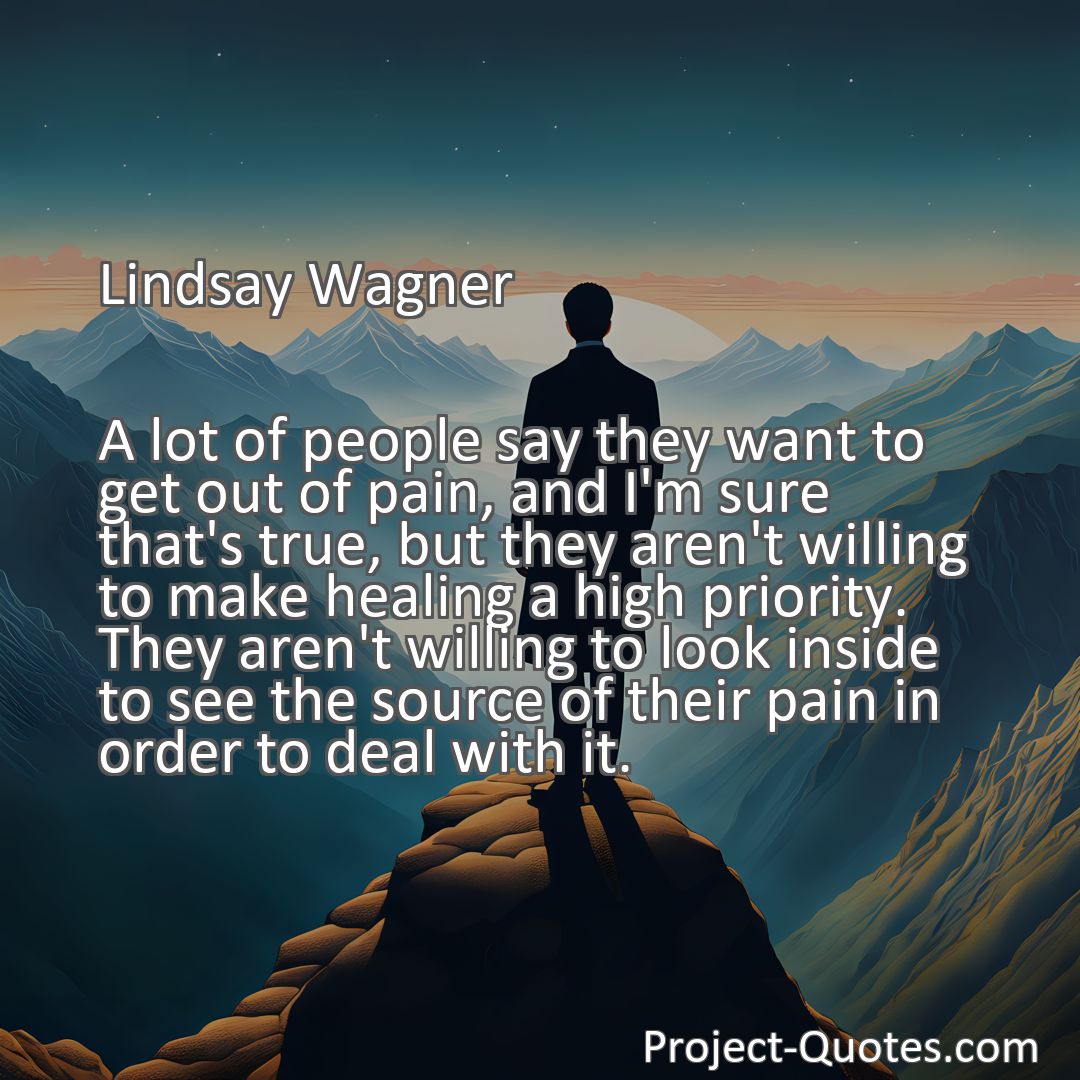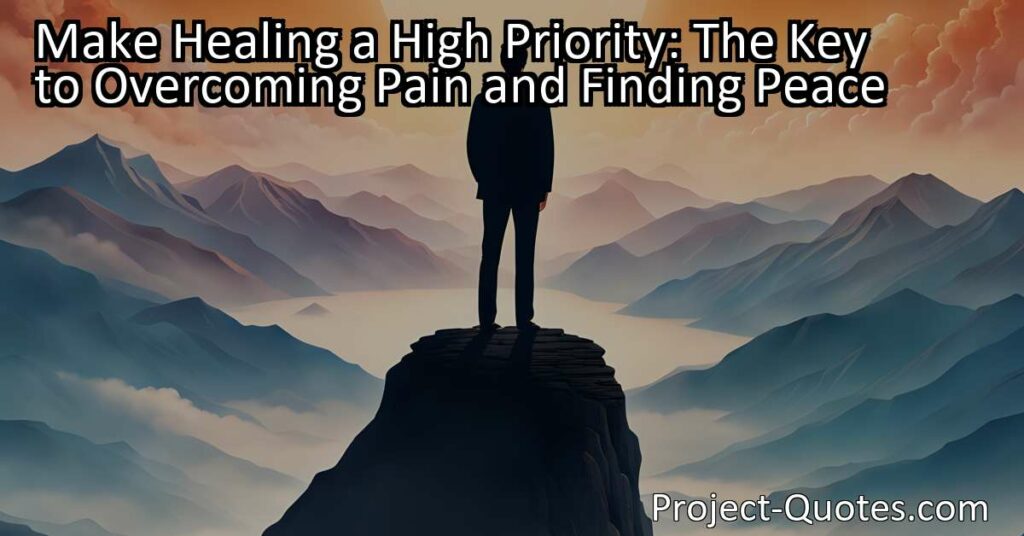A lot of people say they want to get out of pain, and I’m sure that’s true, but they aren’t willing to make healing a high priority. They aren’t willing to look inside to see the source of their pain in order to deal with it.
Lindsay Wagner
Make Healing a High Priority: The Key to Overcoming Pain and Finding Peace Discover the crucial step many people overlook in their quest for relief from pain and discomfort. True healing requires the willingness to look inside, face inner demons, and prioritize self-care. By making healing a top priority in our lives, we can experience improved well-being, stronger relationships, and a more fulfilling life.
Table of Contents
- 1 A lot of people say they want to get out of pain, and I’m sure that’s true, but they aren’t willing to make healing a high priority. They aren’t willing to look inside to see the source of their pain in order to deal with it.
- 2 Lindsay Wagner
- 3 Meaning of Quote – A lot of people say they want to get out of pain, and I’m sure that’s true, but they aren’t willing to make healing a high priority. They aren’t willing to look inside to see the source of their pain in order to deal with it.
- 4 Freely Shareable Quote Image
- 5 Related
Meaning of Quote – A lot of people say they want to get out of pain, and I’m sure that’s true, but they aren’t willing to make healing a high priority. They aren’t willing to look inside to see the source of their pain in order to deal with it.
Many people go through life feeling pain – emotional, physical, or even spiritual. It’s a natural human instinct to want to escape from pain and find relief. We all crave happiness, comfort, and peace of mind. However, one of the crucial aspects that many people overlook is the willingness to make healing a high priority.
When we talk about healing, we’re not just referring to physical wounds or injuries. Healing goes beyond mere physicality; it encompasses our mental and emotional well-being as well. It’s about addressing the root causes of our pain and actively working towards resolving them. But how can we expect to heal if we’re not willing to look inside and examine the source of our pain?
For some individuals, this may seem like a daunting task. Delving into our own psyche and facing our inner demons requires courage, vulnerability, and self-reflection. It’s easier to ignore the discomfort and carry on with our daily lives, hoping that the pain will magically dissipate on its own. However, true healing requires introspection and an honest assessment of our own thoughts, behaviors, and experiences.
So why do so many people avoid this essential step in the healing process? Well, the answer lies in the fear of what they might discover. It can be unsettling to confront our past traumas, unresolved conflicts, or negative patterns of thinking. It’s far more comfortable to remain in the familiar territory of pain rather than venturing into the unknown terrain of self-discovery.
Another reason why many individuals shy away from delving into their pain is the misconception that healing is a time-consuming and arduous process. We live in a fast-paced world where instant gratification and quick fixes have become the norm. As a result, the idea of investing time and effort into healing can seem overwhelming and unattainable. However, true healing is a journey – a gradual and transformative process that requires patience and persistence.
Moreover, some people may feel hesitant to prioritize healing simply because they believe it takes away from other aspects of their lives. They may feel guilty for focusing on themselves instead of tending to family, work, or other obligations. However, it’s essential to recognize that healing is not a selfish act; it’s an act of self-care. By committing to our own healing, we become better equipped to support and care for others in a more authentic and meaningful way.
Additionally, it’s important to note that healing is not a one-size-fits-all solution. Each individual’s journey towards healing is unique and personal. What works for one person may not work for another. Therefore, it’s crucial to find the right strategies and techniques that resonate with our own experiences and needs.
One powerful tool for healing is therapy or counseling. Talking to a trained professional provides a safe and non-judgmental space to explore our pain, gain insights, and develop coping mechanisms. Therapists can help us navigate through our emotions, challenge our limiting beliefs, and provide guidance on how to overcome obstacles. They empower us to take charge of our healing journey and support us along the way.
Another vital aspect of healing is self-care. Engaging in activities that bring joy, relaxation, and peace to our lives can enhance our overall well-being. This could include hobbies, exercise, spending time in nature, practicing mindfulness or meditation, or simply taking a break from the busyness of daily life. By prioritizing self-care, we nurture ourselves and create space for healing to unfold.
Furthermore, seeking support from loved ones can be immensely beneficial. Sharing our struggles and pain with trusted friends or family members can provide emotional solace and a sense of belonging. It’s important to surround ourselves with individuals who uplift and encourage us on our healing journey. Their support, empathy, and understanding can make a world of difference in our ability to heal.
In conclusion, while many individuals express a desire to escape pain, not everyone is willing to make healing a high priority. However, true healing requires us to look within, face our pain head-on, and commit to the transformative journey of self-discovery. Although it can be challenging and intimidating, the rewards of healing are immeasurable improved mental and emotional well-being, enhanced relationships, and a more authentic and fulfilling life. So, let’s be brave, let’s be willing, and let’s make healing a top priority in our lives.
I hope this quote inspired image brings you hope and peace. Share it with someone who needs it today!


